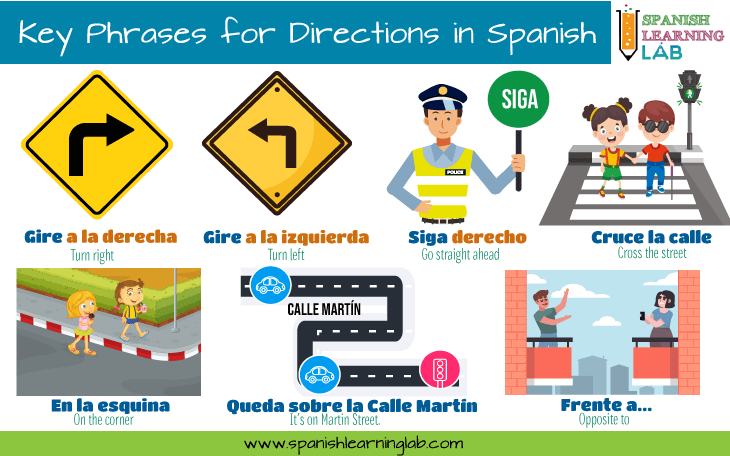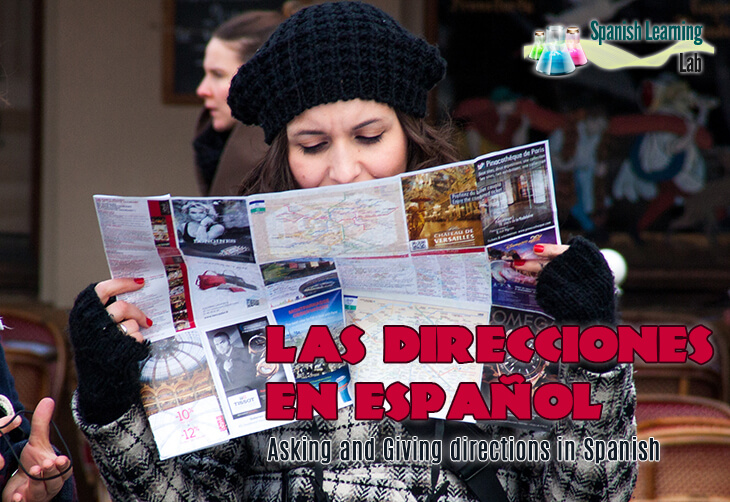In a previous lesson, we learned part of the vocabulary for places in town. We also discussed a little about different ways to ask and give directions in the language. This lesson will focus on introducing some new phrases and contextualize the vocabulary in conversations where people need to ask or give directions in Spanish. As usual, we have included a nice video, many examples, listening activities and interactive quizzes. Let’s start…
Introductory video: Asking and giving directions in Spanish
This video will introduce different ways to ask for directions in Spanish, the basics about prepositions of place to indicate the location of places in town, and how to use the verbs ESTAR, QUEDAR and the form HAY from the verb HABER. It also explains how to use some phrases that will be part of the sample conversations, such as: “Siga” (Go on), “A la izquierda” (to the left) and others. Make sure to stick until the end of the video and then solve the interactive quiz about it.
Words and phrases for asking and giving directions in Spanish
As we explained in the video, most of the time, people will talk about places by using the verbs ESTAR, QUEDAR and others. Generally, the verb ESTAR will be used in two of its forms: ESTÁ for a single place (un hotel) and ESTÁN for several places (dos hoteles), as shown in these examples:
- El hotel está (ubicado) frente al estadio. (The hotel is opposite to the stadium)
- Las tiendas están (ubicadas) sobre la avenida central. (The shops are on central avenue.)
Likewise, QUEDAR will be used in the forms QUEDA and QUEDAN, exactly with the same meaning as ESTAR:
- La cafetería queda a lado de ese edificio. (The cafeteria is next to that building)
- Los mejores restaurantes quedan cerca de aquí. (The best restaurants are close by.)
Following a similar pattern, you can ask for directions in Spanish using a question with either ESTAR or QUEDAR, just as shown in here:
- “¿Dónde queda/quedan + lugar (es)?” – ¿Dónde queda el hospital? (Where is the hospital?)
- “¿Dónde está/están + lugar (es)?” – ¿Dónde está la escuela? (Where is the school?)
- “¿Cómo llego a + lugar?” – ¿Cómo llego al banco? (How do I get to the bank?)
Essential phrases and verbs in addresses
Some words that will come really handy when giving directions in Spanish are: “aquí” (here), “ahí”(there), “doblar”(turn), “cruzar” (cross), “llegar” (arrive). These phrases can be used when reading a map to explain how to get to different places. Similarly, the phrases “Para llegar a ” (to get to…) and “Para ir a…” (to go to…) are extremely useful for this topic. Pay attention to the key phrases presented in the following image:

Short conversations in Spanish about directions
Here is the first conversation about directions using the expressions and questions that we have presented so far, plus some new ones.
Where is the bank? – ¿Dónde está el banco?
- Alika: Vicente ¿Dónde está el banco?
- Vicente: El banco está frente al hospital San Judas
- Alika: Gracias. Tengo que ir al banco ahorita
- Vicente: Bueno si está cerrado, hay otro banco junto a la Farmacia Estrella.
- Alika: Gracias. Entonces voy a ir al banco que está cerca del hospital San Judas.
- Vicente: Está bien ¡Buena suerte!
Where is the restaurant? – ¿Dónde queda el restaurante?
- Carlos: Roberto ¿Dónde queda este restaurante?
- Roberto: uhmm… déjame ver… Queda sobre la calle central, enfrente del hotel Villa.
- Carlos: ¿Hotel Villa? No tengo idea dónde queda.
- Roberto: No sabes dónde queda. Está bien. Miremos el mapa.
- Carlos: Comencemos por la calle central.
- Roberto: Para llegar a la calle central toma el bus No. 1 y te bajas en la estación de policía. Luego caminas dos cuadras hacia el norte.
- Carlos: ¿Este es el restaurante?
- Roberto: No, no es este. Cuando llegues al restaurante italiano, dobla a la derecha y camina unos 50 metros para llegar al Hotel Villa.
- Carlos: Entiendo. El restaurante está al cruzar la calle entonces.
- Roberto: ¡Exacto!
Other words and phrases for giving directions in Spanish
When you have no idea where a specific place is located, then you can use the phrase “No sé dónde queda” or “No sé dónde está”. If you want to confirm the location of place, just change the intonation of your sentence and make it sound like a question, just like in these examples: “¿El cine queda aquí?” (Is the cinema here?) and “¿El restaurante está al cruzar la calle?”. (Is the restaurant across the street?)
The second example will show other words and phrases for giving directions in Spanish. This conversation is more polite and includes the verbs “Saber” (to know), “Perderse”(to get lost), “caminar” (walk), “pedir” (ask for) and “haber”. You can tell people to walk straight ahead by using the phrases “camina derecho” or “camina en esta calle”. You could use phrases such as “a la derecha”(to the right), “a la izquierda” (to the left) and prepositions like close (cerca) or far away (lejos). Listen to the sample conversation and check how they use some of these expressions for asking and giving directions in Spanish.
Where is the bus station? – ¿Dónde queda la estación de buses?
- Miguel: Disculpa ¿Sabes dónde está la estación de buses?
- Claudia: Si, es cerca de aquí. Solo tienes que caminar 2 cuadras recto, luego gira a la derecha y camina 1 cuadra más. La estación está justo en frente de una escuela primaria.
- Miguel: Gracias. ¿Qué otros lugares hay cerca de la estación?
- Claudia: Hay un supermercado y varias tiendas. No te preocupes, es fácil llegar. Si te pierdes, puedes pedir ayuda en la estación de policía que también queda cerca.
- Miguel: Gracias por tu ayuda, espero no perderme.
- Claudia: De nada. Buena suerte.
Where’s the pharmacy? – ¿Dónde está la farmacia?
- Carlos: ¿Dónde está la farmacia más cercana?
- Ana: Está sobre la Calle Aurora, justo al lado de una clínica dental y frente a la gasolinera.
- Carlos: Gracias. Ayer estuve por ahí, pero no vi ninguna farmacia.
- Ana: ¿En serio? Qué raro. Quizás la movieron a otro lugar. Revisemos.
- Carlos: Sí, mejor confirmemos la dirección antes de ir.
- Ana: Sí, mira. Ahora están ubicados sobre la Calle Diamante, cerca de este parque que aparece en el mapa.
- Carlos: ¿Es la calle donde queda el hospital?
- Ana: Esa misma. Puedes tomar un bus, te bajas frente a este banco y luego caminas dos cuadras al sur. Mira, también hay un supermercado y varios restaurantes cerca de la farmacia.
- Carlos: Gracias, ya estoy seguro de la dirección del lugar.
Listening Activity: Getting around town in Spanish – ¿Sabes dónde queda?

Key expressions in the conversation:
- “Pasar tiempo haciendo algo…” means “to spend time doing something”
- “Después de todo…” means “After all”
Extra practice: Talking about directions of places in Spanish
Read the lines of this conversation carefully. It includes much of the vocabulary and structures in the lesson. Then, press “Check” when you finish moving the lines up and down.
Homework:
Think about the following questions and then write their answers and read them out loud to practice your pronunciation.
- ¿Cuál es el lugar más interesante de tu ciudad?
- ¿Dónde está ubicado?
- ¿Qué recuerdas de la última vez que fuiste ahí?
Related Spanish Worksheets:
- Places in the City in Spanish (Vocabulary + Sentences)
- Adjectives to Describe Places in Spanish
- Giving Directions in Spanish (City map + sentences)
- Places and Directions in Spanish (City map + sentences)
- Asking for Directions in Spanish
- Giving directions in Spanish (Dialogues)
- Travel Postcards in Spanish (Reading)
- Places and their Location in Spanish (Reading)

Pretty good site, good for Spanish learners.
In the third conversation (with Miguel and Claudia), why does Miguel use está in the first line and Claudia use es to answer him?
That’s a great question. Actually, the correct way if we follow grammar rules would be “Si, está cerca de aquí” or “Si, queda cerca de aquí”. However, in real conversations people will sometimes use ES for places, especially with the words “AQUÍ” and “AHÍ”, e.g. “Es aquí” (It’s here), “Es ahí” (It’s there). ESTAR would be the most common to talk about location and directions though. 🙂 Hope it helps!
I got all 5 questions correct on my first try.